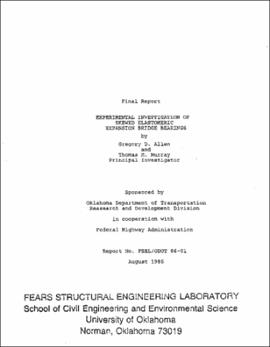| dc.description.abstract | Twelve skewed elastomeric expansion bridge bearings were supplied by
the Oklahoma Department of Transportation. To evaluate the performance of
these skewed bearings, the following six phases of testing were conducted on
each of the twelve bearings: I. Shear and compressive stiffness tests, II.
Fatigue cycles representing 50 years of service·with parallel bearing surfaces,
III. Shear and compressive stiffness tests, IV. Shear stif.fness tests
with bearings at sub-freezing temperatures, V. Fatigue cycles representing 50
years of service with rotated bearing surfaces, and VI. Shear stiffness tests
Phase I formed the basis of comparison with the post-fatigue results from
Phases III and VI, and the low temperature tests from Phase IV. It was found
that the fatigue loading with parallel bearing surfaces had very little effect
on the compressive and shear stiffnesses of the skewed bearings. Some 'degradation
of shear stiffness was found after the fatigue loading with rotated
bearing surfaces, Phase V. However, the combined degradation due to both
fatigue loadings was considered insignificant.
It was found that the simple shear equation for estimating the shear
stiffnesses of the twelve bearings wgs very conservative and no correlation
was evident between predictions an.cl the·· experimental results of Phase I. In
general, the shear stiffness cha.nged more rapidly than the change in bearing
area as the skew angle decreased ftom 90° (rectangular).to 300.
As an outgrowth of the experimental work, design expressions for determining
the effective shear stiffnesses of both skewed and rectangularbearings
with turned axes were developed. Excellent correlation was found between
shear stiffness predictions from the proposed equations and the experimental
results. | |
